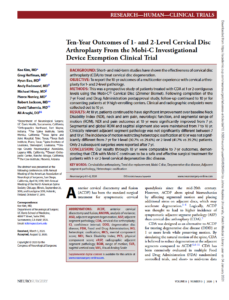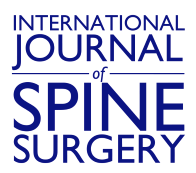
Abstract
BACKGROUND: Short- and mid-term studies have shown the effectiveness of cervical disc arthroplasty (CDA) to treat cervical disc degeneration.
OBJECTIVE: To report the 10-yr outcomes of a multicenter experience with cervical arthroplasty for 1- and 2-level pathology.
METHODS: This was a prospective study of patients treated with CDA at 1 or 2 contiguous levels using the Mobi-C® Cervical Disc (Zimmer Biomet). Following completion of the 7-yr Food and Drug Administration postapproval study, follow-up continued to 10 yr for consenting patients at 9 high-enrolling centers. Clinical and radiographic endpoints were collected out to 10 yr.
RESULTS: At 10 yr, patients continued to have significant improvement over baseline Neck Disability Index (NDI), neck and arm pain, neurologic function, and segmental range of motion (ROM). NDI and pain outcomes at 10 yr were significantly improved from 7 yr. Segmental and global ROM and sagittal alignment also were maintained from 7 to 10 yr. Clinically relevant adjacent segment pathology was not significantly different between 7 and 10 yr. The incidence of motion restricting heterotopic ossification at 10 yr was not significantly different from 7 yr for 1-level (30.7% vs 29.6%) or 2-level (41.7% vs 39.2%) patients. Only 2 subsequent surgeries were reported after 7 yr.
CONCLUSION: Our results through 10 yr were comparable to 7-yr outcomes, demonstrating that CDA with Mobi-C continues to be a safe and effective surgical treatment for patients with 1- or 2-level cervical degenerative disc disease
To Read The Full Article Click Here





